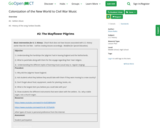
#2: Settlers Music#3: History of the song Yankee Doodle.
- Subject:
- U.S. History
- Material Type:
- Lesson Plan
- Author:
- Diane Raikis
- Date Added:
- 11/18/2021

#2: Settlers Music#3: History of the song Yankee Doodle.
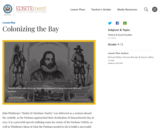
This lesson focuses on John Winthrop's historic "Model of Christian Charity" sermon which is often referred to by its"City on a Hill" metaphor. Through a close reading of this admittedly difficult text, students will learn how it illuminates the beliefs, goals, and programs of the Puritans. The sermon sought to inspire and to motivate the Puritans by pointing out the distance they had to travel between an ideal community and their real-world situation.
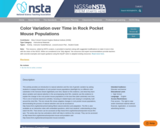
This activity provides an introduction to natural selection and the role of genetic variation by asking students to analyze illustrations of rock pocket mouse populations (dark/light fur) on different color substrates in the Sonoran Desert (light/dark) over time. Based on this evidence, and what they learn about variation and natural selection in the accompanying short film, students use this evidence to explain the change in the rock pocket mouse populations on the lava flow (dark substrate) over time. This is one of several classroom activities, focusing on related topics and varying in complexity, built around the short film. This ten minute film shows adaptive changes in rock pocket mouse populations, demonstrating the process of natural selection and can be accessed at http://www.hhmi.org/biointeractive/making-fittest-natural-selection-and-adaptation. The film is also available as an interactive video with embedded questions, which test students understanding as they watch the film.

This classroom activity for high school students uses a collection of Hubble Space Telescope images of galaxies in the Coma Cluster. Students study galaxy classification and the evolution of galaxies in dense clustered environments.
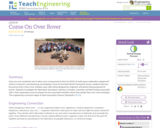
Have you ever wondered why it takes such a long period of time for NASA to build space exploration equipment? What is involved in manufacturing and building a rover for the Red Planet? During this lesson, students will discover the journey that a Mars rover embarks upon after being designed by engineers and before being prepared for launch. Students will investigate the fabrication techniques, tolerance concepts, assembly and field-testing associated with a Mars exploratory rover.

These curriculum materials for Grade 7 English Language Arts are separated by the full curriculum Modules (developed by Expeditionary Learning for New York State) and Units in the Developing Core Proficiencies Series (developed by Odell Education for New York State). The resources include Grades 6-8 ELA Curriculum: Appendix 1: Teaching Practices and Protocols; Grades 6-8 ELA Curriculum: Appendix 2: Graphic Organizers; and a Grades 6-8 English Language Arts Curriculum Map.
**NOTE: The New York State Education Department shut down the EngageNY website in 2022. In order to maintain educators' access, nearly all resources have been uploaded to archive.org and the resource links above have been updated to reflect their new locations.**
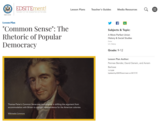
This lesson looks at Thomas Paine and at some of the ideas presented in his pamphlet, "Common Sense," such as national unity, natural rights, the illegitimacy of the monarchy and of hereditary aristocracy, and the necessity for independence and the revolutionary struggle.
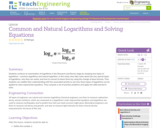
Students continue an examination of logarithms in the Research and Revise stage by studying two types of logarithms—common logarithms and natural logarithm. In this study, they take notes about the two special types of logarithms, why they are useful, and how to convert to these forms by using the change of base formula. Then students see how these types of logarithms can be applied to solve exponential equations. They compute a set of practice problems and apply the skills learned in class.
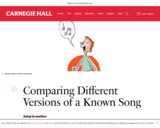
Students create different versions of a known song and listen to contrasting recordings for musical differences and similarities.
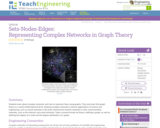
Students learn about complex networks and how to represent them using graphs. They also learn that graph theory is a useful mathematical tool for studying complex networks in diverse applications of science and engineering, such as neural networks in the brain, biochemical reaction networks in cells, communication networks, such as the internet, and social networks. Topics covered include set theory, defining a graph, as well as defining the degree of a node and the degree distribution of a graph.
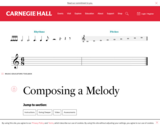
Students compose and notate short melodies using their names.
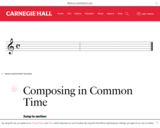
Students compose and notate short 4/4, 3/4, and 6/8 rhythms across multiple class periods.
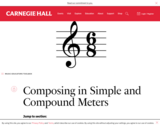
Students compose and notate short rhythms in 4/4, 3/4, and 6/8 meters across multiple class periods.
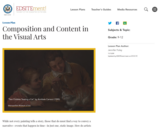
How do artists create a story that provides a message or provokes emotions in that single frame? This lesson will help students analyze ways in which the composition of a painting contributes to telling the story or conveying the message through the placement of objects and images within the painting.

Students learn how the total solar irradiance hitting a photovoltaic (PV) panel can be increased through the use of a concentrating device, such as a reflector or lens. This is the final lesson in the Photovoltaic Efficiency unit and is intended to accompany a fun design project (see the associated Concentrating on the Sun with PVs activity) to wrap up the unit. However, it can be completed independently of the other unit lessons and activities.
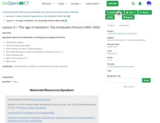
Big Ideas/Topics to be Addressed, including Key Concepts and Terms Ways slaves resisted Denmark Vesey-Slave Revolt Role of Black Churches in Slave Resistance The Haitian Revolution inspired the abolition movement in the U.S. Role of Abolitionists Black Communities in CT Black Press Vocabulary: Slave Resistance, Abolition, Gradualist Period, Negro Spirituals
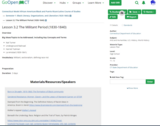
Big Ideas/Topics to be Addressed, including Key Concepts and Terms Nat Turner Underground Railroad Harriet Tubman La Amistad (1839-1841) Vocabulary: Militant, sectionalism, defining race riot
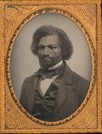
Big Ideas/Topics to be Addressed, including Key Concepts and Terms Leadership Agent for Change: Frederick Douglass American and Foreign Anti-Slavery Society American and Foreign Anti-Slavery Society Compromise of 1850 & the Fugitive Slave Act of 1850 Bleeding Kansas (1854-1861) Dred Scott Decision (1857) John Brown’s Raid on Harpers Ferry (1859) Artwork: National Portrait Gallery, Smithsonian Institution; acquired through the generosity of an anonymous donor, 1856
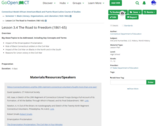
Big Ideas/Topics to be Addressed, including Key Concepts and Terms Impact of the Emancipation Proclamation Role of Black Connecticut soldiers in the Civil War Impact of the Civil War on Blacks in the North and in the South Reasons for Union victory in the Civil War
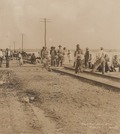
Big Ideas/Topics to be Addressed, including Key Concepts and Terms Failed promises of the Reconstruction era created dissonance among Blacks and Whites During the Nadir, in the North as well as the South, whites forced African Americans from skilled occupations like carpentry and unskilled jobs like mail carrier Connecticut and the Great Migration to Hartford Nadir (low point) - the ideology of race relations and underlying social processes Riot vs. massacre: How the narrative is told matters in terms of how the event is received. “Red Summer 1919” Status of Black soldiers after WWI Black WWI veterans fought abroad as Americans and returned home to be viewed as a “threat” to the status Vocabulary: Great Migration, Juxtaposition, Riot, Tulsa massacre, Black wall Street, Red Summer, Langston Hughes Artwork: Gelatin silver print of the 1927 Mississippi River flood © 1927 Illinois Central Railroad Collection of the Smithsonian National Museum of African American History and Culture